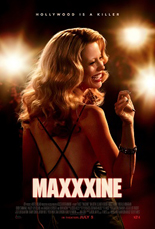Monday, Jan. 1, 2024 — a date which will live in infamy — the original version of Mickey Mouse scampered into the public domain. And enterprising filmmaker Simon Phillips was ready, dropping a trailer for the slasher flick Mickey’s Mouse Trap.
Now simply titled The Mouse Trap, it borrows the Star Wars crawl to deliver a disclaimer erring on the side of the caution, lest someone confuse this for actual Walt Disney Company product. With this Mickey teleporting and stabbing, how could they?
At the FunHaven arcade, the manager (Phillips) forces Alex (Sophie McIntosh, The Sacrifice Game) to work late on her 21st birthday for a party that’s rented out the place. Turns out, it’s for Alex — a pretty shitty thing for her “friends” to do, if you ask me. They kick off a night of sex, drugs and Skee-Ball — all spoiled by the Mickey-masked manager, who kills them one by one … and sometimes by two, somehow hiding within a space that isn’t exactly a labyrinth.

Why become such a fun-killer? If Phillips knows, his script doesn’t show it. As far as I could muster, it’s because the manager spills a drink on a frayed cord of a film projector loaded with Mickey’s debut cartoon, Steamboat Willie, thereby transforming him into a homicidal maniac. I suppose that could happen, question mark.
Unlike the similar Winnie-the-Pooh: Blood and Honey, the movie is watchable, with Deinfluencer director Jamie Bailey giving it more of the rhythms that resemble a “real” film. Also unlike Blood and Honey, in a select few spots, it approaches fun. (One of them: Asked whether she’s ever seen a horror movie, a young woman answers, “No, Marcus, I have a sex life!”)
But very much like Blood and Honey, The Mouse Trap is first and foremost a rushed-out cash grab, existing only to exploit Disney’s copyright loss before anyone else could, quality be damned. Another commonality the two flicks share: just ending without an ending. While I get the curiosity factor, this chunk of cheese isn’t worth taking the bait. —Rod Lott











